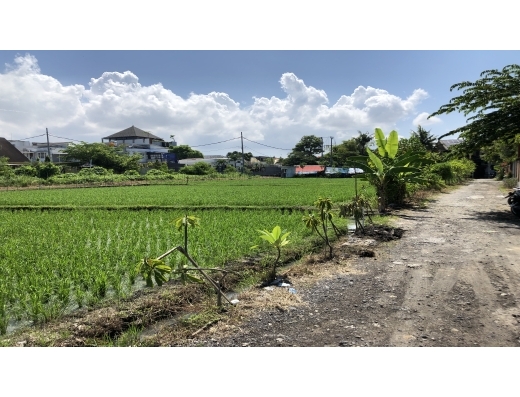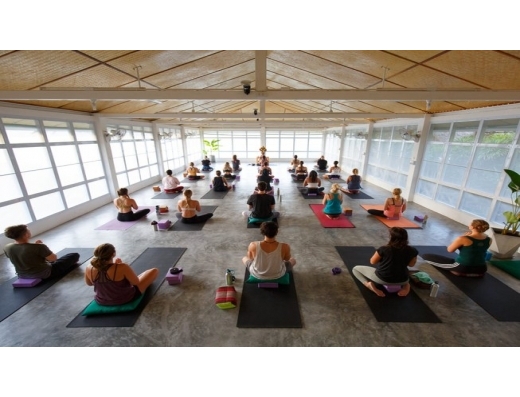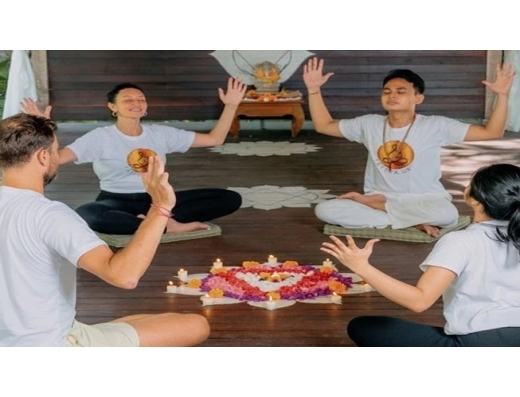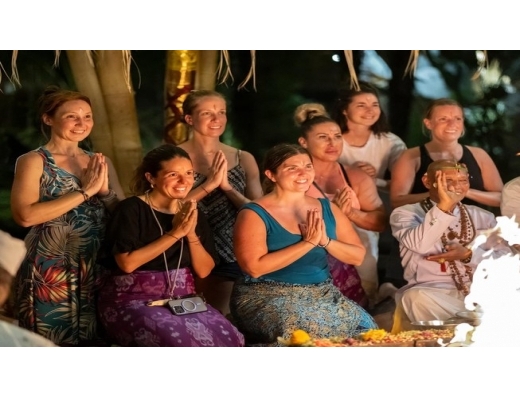Kundalini Yoga Teacher Training in Indonesia
If you wanna dive deeper into Kundalini Yoga, this yoga teacher training program in Bali is an awesome option. Experienced instructors will guide you through a comprehensive curriculum covering the philosophy, practice, and teaching methodology of Kundalini yoga. You’ll get to explore advanced Kundalini yoga practices like kriyas, meditations, and pranayama throughout the program.
Program
During your stay in Bali, you'll enjoy daily Kundalini yoga classes, workshops, and excursions to explore the island. You'll also explore the principles of teaching Kundalini yoga and develop your teaching skills through practice teaching and feedback sessions. You'll stay in comfortable accommodation and enjoy delicious vegetarian meals.
Who can join this course?
- If you are new to yoga (no specific background in yoga is required, being eager to learn is enough)
- If you have been practicing yoga for a while
- If you have been practicing yoga for a long time but do not have knowledge of anatomy, the foundation of the asanas, and yoga philosophy
- Do not want to be a yoga teacher but desire to deepen your own yoga practice and knowledge
Walk on your yogic path with Bali Yoga Retreats
They give a holistic understanding of yoga which offers multi-style yoga practices combined with traditional yoga and a recent, modern understanding of the body. Their gurus are ready with all their hearts and knowledge to guide you and support you to deepen your yoga practice and achieve your goals. Join Bali Yoga Retreats' family and experience the endless joy of discovering your true self and this life-transformative journey.
If you need to leave early
- If you have an emergency and need to leave before your course ends for one or two days, they can arrange to complete the full course requirements in time.
- If you need to leave earlier than one or two days, you will have to complete the course online. Then the certificate will be sent after passing the examination.
Overview
1. Mantra and Chanting
Mantra
Mantra is a set of words that consist of specific sounds, and vibrations received by ancient yogis, and seers that offer a powerful physical, mental, and spiritual benefit.There are many kinds of Mantras available for different purposes. You will be learning:
- Art and science of mantra
- Mantra and its power
- How mantra is made
- Is mantra a religion
- Sound vibration
Mantra chanting
- The proper way of chanting the Om mantra
- Shiva mantra for peace
- Durga mantra for energy awakening
- Kundalini mantra
- Krishna mantra for joy
- Ganesha mantra for stillness and removal of obstacles
- Mantra to be led towards light and immortality (asatoma)
- Surrender mantra (twamevamata)
- Mantra to save life and journey (trayamvakam)
- Mantra for purification of the mind (Gayatri)
- Guru-disciple study mantra (Sahana)
- Guru mantra (guru brahma)
- Patanjali mantra (yogenacittasya)
- Suryanamaskar 12 mantra (om mitraya)
2. Kundalini yoga asana
- Bhujangasana (cobra pose- to the awake heart chakra)
- Prarthanasana (the prayer pose -to have reverence)
- Padahastasana (the standing forward bend – to wake muladhara chakra)
- Tadasana (the tree pose – for nourishing our spiritual aspiration)
- Trikonasana (the triangle pose)
- Sahaja agnisar dhauti (awakening inner fire – in Manipura chakra)
- Vajrasana (thunderbolt pose -to cleanse vajra nadi to promote ascendance of the sexual energy towards upper chakras)
- Shalabhasana (the locust pose –Increases the blood supply to the sacrum and lower back)
- Dhanurasana (the bow pose – remove constipation and improve digestion)
- Ardha matsyendrasana (the lord of the fishes pose)
- Uddiyana bandha (upward flying lock)
- Paschimottanasana (the back stretching pose)
- Janushirshasana (the head-to-knee pose- eliminate laziness and weakness)
- Ushtrasana (the camel pose-arousing manipura chakra)
- Naukasana (the boat pose – alleviates anxiety and nervousness)
- Supta vajrasana (the reclining thunderbolt pose – guides the sexual energy through vajra nadi towards the brain)
- Garudasana (the eagle pose – improve balance and coordination)
- Nauli kriya (the navel cleansing- balance the three senses of humor of the body kapha-vata-pitta)
- Ardha shirshasana (half headstand- rejuvenate the brain cells)
- Shashankasana (the hare pose – remove stress, arrogance, selfishness, and anger)
- Pavanamuktasana (massages the internal organ and decongests the liver and sexual organs)
3. Kundalini joints movements
- Warm-up exercises
- Feet and ankle exercises
- Knee movement
- Hip movement and rotation
- Leg cradle
- Side bending
- Arms movement
- Arm swing
- Elbow movement
- Wrist and hand movement
- Neck exercises
- Chin, jaw, mouth, tongue, eye, and head exercises
4. Kundalini awakening
- Rules and preparation
- Postures
- Chakra sadhana
- Practices to awaken Ajna chakra
- Practices to awaken Mooladhar chakra
- Practices to awaken Swadhisthan chakra
- Practices to awaken Manipura chakra
- Practices to awaken Anahata chakra
- Practices to awaken Vishuddhi chakra
- Practices to awaken Bindu
- Practices for chakra awareness
- Moola Sshakti bandha (root energy lock)
- Uddiyana shakti bandha (abdomen energy lock)
- Jalandhar shakti bandha (throat energy lock)
- Maha shakti bandha (great energy lock)
5. Hatha yoga
Bali Yoga Retreats teaches the traditional ancient style of Hatha yoga that has been practiced by the Himalayan masters for thousands of years. At our school, you practice according to your strength and flexibility. The main purpose is to attain perfect health and peace of mind.Here is the list of asana series that will be practiced:
- Pavan Muktasana series 1 (15 practices)
- Pavan Muktasana series 2 (10 practices)
- Pavan muktasana series 3 (10 practices)
- Centering postures series (5 practices)
- Surya namaskar (12 asana series)
- Chandra namaskar (12 asana Series)
- Standing postures series (10 practices)
- Kneeling postures series (5 practices)
- Sitting postures series (10 practices)
- Forward bending postures series (5 practices)
- Backward bending postures series (5 practices)
- Supine postures series (6 practices)
- Prone postures series (5 practices)
- Fire series series (5 practices)
- Inversions series (5 practices)
- Twisting postures series (5 practices)
- Balancing postures series (5 practices)
- Relaxing posture series (5 practices)
- Meditative asana series (5 practices)
Note: In total, you will learn 140 yoga exercises
6. Pranayama
Pranayama is the central practice of traditional yoga. Many people misunderstand Pranayama as the breathing practice only, but it is something more.In this class, you will learn the secret of pranayama and how it leads us to health, peace, happiness, balance, and the awakening of kundalini.Every week will lead to a different state of experience:
- Building strength in your system and a step-by-step understanding of pranayama
- Move towards from the beginning to a deeper understanding of pranayama and practices
- Move towards advancing the practices by holding your breath and breathing with chakra awareness
- Practice teaching and move towards mastery of the breath
Here are the topics you will be learning for the study of pranayama:
- What is prana
- What is pranayama
- What is breath and connection with the prana
- Importance and benefits of pranayama
- How to prepare ourselves to practice them
- Aspects of breathing
- Ancient texts of breathing
- General understanding
- Understand all about nostrils and how to activate them
- Secrets of pranayama
- Breath flow in five elements
- Unit of prana
- Function of prana
- Three levels of prana
- Three Gunas
- How does prana flow
- Quality of breath
- Imbalance of prana
- Retention of breath
- 6 sitting positions for pranayama practices
- Breathing pattern
- Prana connection with chakras and Kundalini
Beginners and intermediate practices
- Clavicular pranayama
- Thoracic pranayama
- Diaphragmatic pranayama
- Yogic pranayama
- Pranava pranayama
- Nadisodhanam pranayama
- Bhastrika pranayama
- Kapalbhati pranayama
- Bhramari pranayama
- Ujjayi pranayama
- Sitli pranayama
- Sitkari pranayama
- Murcha pranayama
- Surya bhedi pranayama
- Chandra bhedi pranayama
7. Meditation
Once you stabilize your posture through asana, cleanse your energy through pranayama, and control your senses through pratyahara, you will be able to focus your mind.Meditation starts with concentration practices and with this 200-hour YTTC, you will learn great techniques to master the basics by which you can develop a high-level concentration and awareness.With this 20-day program, you will learn basic to intermediate levels of meditation preparations and techniques. Each day you will get a little more understanding of how to perform them and experience their benefits.
- Developing foundation
- Developing one-pointed focus, different types of concentration techniques, and visualization exercises
- Meditation techniques
- Chakra awareness and Kundalini meditation
Here is the list of what you will be learning:
- Introduction to meditation
- History of meditation
- Preparation for meditation
- What is meditation and what it is not
- Why- how- where- when meditation
- Philosophy of meditation
- Meditation traditions
- Meditation scriptures
- Aim and objectives of meditation
- Sitting positions
- How to sit correctly
- Preliminary practices before practicing meditation
- Role of diaphragmatic breathing in meditation
- Correct breathing in meditation
- How to relax in meditation
- Lifestyle- diet- sleep- sex- job- rules in meditation
Styles of meditation practices
Himalayan meditation practices
- Basics foundation meditation practice
- Breath- mind- mantra awareness
- Tratak meditation
Nada meditation practices
- Music meditation
- Om meditation
- Mantra power meditation
Active meditation practices
- Dynamic moving meditation (Osho)
- Buddha walking meditation
- Karma yoga meditation
- Gaurishankar meditation
Tantra and Kundalini meditation practices
- 7 chakra awareness meditation
- Ajna chakra awakening meditation
- Kundalini active meditation
Vipassana and passive meditation practices
- Breath awareness (anapana)
- Mindfulness and sensation
- Total awareness practice
- Mantra and Kirtan meditation practices
- How to do Japa (recitation)
- Kirtan even and creates a spiritual vibe
- Silence practice
- One-day silence meditation
8. Yoga Nidra
Yoga Nidra (sleep awareness/ psychic sleep) is a journey from a conscious to a superconscious state of awareness. All animals, birds, insects, and humans sleep in the same way, and the experience of sleep also is the same. This state brings oneness and there is a great secret behind all of it.Yogi Vishnu is one of the most famous yoga Nidra teachers. His proven techniques have been practiced for a long time by our sages. He will be the mentor and teacher, showing you how it can transform your life in a very short period of time. yoga Nidra practices will take place every Friday.
- Basic relaxation practices
- Chakra awareness yoga Nidra
You will learn the basics of yoga Nidra
- Meaning and purpose of yoga Nidra
- Different schools and traditions of yoga Nidra
- Tantric origin of yoga Nidra
- Lifestyle and rules for yoga Nidra practitioners
- Benefits and risks of yoga Nidra
- Difference between yoga Nidra and meditation
- Yoga Nidra experience
- Yoga Nidra and healing
- 4 states of consciousness
- 3 body awareness
- Tension relaxation
9. Yoga cleansing
The body produces toxins at all times and you need to cleanse your body accordingly. Proper ablution, urination, and cleaning of nostrils, ears, eyes, skin, tongue, and other organs are very important for good health. These are physical, mental, emotional, al, and spiritual cleansing.In the beginning, yoga practitioners should follow six practices (shatkarma) by which they can unblock the channels for higher experiences. With your 200-hour YTTC, you will learn these cleansing practices. You will also learn the basic theory of the following:
- What is shatkarma
- Benefits and risks
- Who should and should not practice it
- Experiences
- Preparation to shatkarma
- Practices after completing It
- Nadi cleansing
Practices that you will learn
- Jiwa dhauti
- Data-Dhauti
- Karna-Dhauti
- Rubber-net
- Jalaneti
- Kapalbhati
- Agnisara
10. Kundalini Tantra philosophy
Yoga philosophy is the philosophy of life. Just by listening and understanding, one can change one's own life. Yogi Vishnu learned the secrets of yoga philosophy from his great Master Swami Veda by spending significant time with him. His authentic teachings will be taught by our teachers.Yoga philosophy does not only exist in the yoga sutra. There are hundreds of yogic texts and Bali Yoga Retreats will introduce you few important ones such as the yoga sutra, Bhagawat Geeta, and Upanishad.During these 20 days, yoga philosophy will take you on a great journey of wisdom.
Entering to the world of wisdom
- Introduction to Indian culture and spirituality, and Himalayan tradition
- Introduction to the ancient scriptures of yoga and spirituality
- Meaning and purpose of Indian philosophy
- Introduction to 9 major Indian philosophy
- Why is yoga philosophy the most important among all?
- History of yoga
- Types of yoga
Patanjali welcomes you – external limbs!
- Patanjali and his work
- Introduction to yoga sutra text
- Eight limbs of yoga
- Yamas and niyamas
- Philosophy of asana and pranayama
- Science of Karma
Inward journey of philosophy – internal limbs!
- Philosophy of concentration, meditation, and Samadhi
- Overview of the first chapter
- Overview of the second chapter
- Overview of the third and fourth chapters of Patanjali
- Mind and its control
- Introduction to Bhagavat Geeta and Upanishad
Exploring the wisdom of yoga
- Chakras
- Nadi
- Kundalini
- Three-fold pain
- Three bodies (sharia)
- Panchakosha
- Tri-guna
- Mahabhuta (theory of elements)
11. Kundalini anatomy
- Nadis / energy channel
- Chakras
- Panchakosha (5 sheaths)
- Respiratory system
- Nervous system
- Tridosha
- Dhatus
- Vayu
12. Yoga therapy
Yoga is a holistic science that nurtures the body, mind, and soul. It has a natural healing energy by which one can remain healthy and if there is any illness, it helps the body heal naturally. You will be learning the basics of yoga therapy in the classes.The teachers will give instructions on the therapeutic value of respective practices during the asana, pranayama, meditation, and anatomy classes. There will be no specific class for it.
- What is yoga therapy
- Rules and regulations of yoga therapy
- Healing through asana, pranayama, and meditation
- Therapy for common diseases
13. Ayurveda
Ayurveda is the sister science of yoga. It believes that the body is made of five elements which create three Doshas: Kapha, Vata, and Pitta. When you keep them balanced, you are healthy and when imbalanced, you are ill.Ayurveda talks about proper health management that all yoga teachers need to know to help people. Bali Yoga Retreats provides one Ayurveda workshop from their doctor.Here is what you will learn in the Ayurveda classes:
- Introduction to Ayurveda
- Unique features of Ayurveda treatment
- Ayurveda and its diversified areas
- Ashtanga Ayurveda
- Fundamentals of Ayurveda
- Panchamahabhuta
- Kapha (the theme of structure and lubrication)
- Vata (the energy of movements)
- Pitta (the energy of bio-transformation and heat generation)
- Prakriti – know your constitution
14. Kundalini Tantra mudra
Mudra is a divine gesture practiced with human hands. There are hundreds of them and they can bring miraculous changes in the body and mind with their extraordinary powers.You will learn about these powerful and secret mudras and their understanding.
- The secrets of mudra
- The position of elements in the hands
- The need for mudra
- The importance and advantages of mudras
- Special guidelines about mudra
- Gyan mudra (gesture of wisdom)
- Purn gyan mudra (gesture of complete wisdom)
- Vairagya mudra (gesture of dispassion)
- Abhaya mudra (gesture of blessing, fearlessness)
- Dyan mudra (meditation mudra)
- Vayu mudra (gesture of air)
- Pran mudra (gesture of prana)
15. Bandha (energy lock)
The whole universe is made of energy. At all times the energy is converted into matter so that you see the whole universe as what it is. Your physical body is also made of energy and it constantly works with it.With mudra channel the energy and with bandha, you control the energy and prevent it from draining. It helps you manage and maintain your energy. It also is helpful for Kundalini awakening.There are only three Bandhas according to yoga but Bali Yoga Retreats will teach you many preparation techniques that will help you perform the bandhas correctly.Here is what you will learn
- Meaning and importance of energy lock
- Why the energy lock and how does the energy get drained
- Energy knots and how to open them
- Understanding the three chakras: Muladhara-Manipura-Visuddhi
- Experience of energy lock
- Benefits and risks of bandha practices
Practices (beginners and intermediate level)
- Agnisar (preparation to uddiyana)
- Vahir kumbhaka (external retention)
- Antar kumbhaka (internal rentention)
- Ashwini mudra
- Vajroli mudra
- Mulabandha
- Uddiyana bandha
- Jalandhara bandha
16. Teaching methodology
Learning or practicing yoga is not enough to teach. Teaching yoga is an art in which you transform people's lives. A proper teaching methodology will help you with:
- Not to forget the sequence
- Avoid injuries
- Manage happiness during and after the practice
- Work with all sides of yoga and all levels
- Give a meditative experience
- Manage and balance the energy flow
Here is what you will learn
- Proper demonstration of a yoga practice
- The proper way to instruct and guide a lesson
- Proper alignment of yoga postures
- Proper adjustment with / without props
- Yogic personality establishment
17. Alignment
- Sense of alignment
- Role of alignment in daily practice
- How to balance prana and chakras
- How alignment works in five koshas
- Importance of alignment
- Different aspects of alignment
- To decrease the risk of injuries
- Increase the movement of joints
- Alignment based on body regions
- Upper limb alignment
- Lower limb alignment
- Torso- thorax- abdomen- pelvis alignment
- Head and neck alignment
- Spinal alignment
- Basic alignment postures
- How to bring the body in a comfortable
- How to find the balance between body and mind
18. Adjustment
- What is the sense of yoga adjustment
- What is the level of yoga adjustment
- Why adjustment is needed in yoga asana
- Role of adjustments in yoga asana class
- Right technique of perfect adjustment
- How to apply a bandha and when
- Exploring the dynamics of each asana
- How to adjust self-adjust in a posture
- How to adjust others during the class
- Pre-required methods of adjustment
- Uses of different tools and props to achieve a peak of the posture
- Body weight management during a posture
- Safety rules and preparations
19. Evaluation and certification
At the end of the course, you will be evaluated and according to that, you will get the certification. Your evaluation will be based on the following:
- Performance during the course
- Attendance
- Practical asana demonstration test
- Written test (objective and subjective type)
- Behavior
Daily schedule – 200-hour yoga TTC
Depending on the yoga school, the mornings can begin as early as 5:30 a.m. with meditation followed by some yoga postures and maybe some classes or lectures in philosophy or anatomy. Chanting and pranayama are also part of the schedule.During training, you are provided with two to three yoga meals, fruit refreshments, and green tea. Daily written homework is also the norm as that is how you gain in-depth knowledge of the subject. Sleeping early is encouraged as that is part of yogic practice.
- 05:00 Wake up
- 05:30-06:30 Silent meditation
- 06:30-08:00 Hatha yoga
- 08:00-08:15 Shatkarma / yoga cleansing
- 08:15-09:15 Pranayama / bandha / mudra
- 09:15 Breakfast
- 10:30-11:30 Self-study
- 11:30 Yoga philosophy
- 12:30 Yoga anatomy
- 13:30-14:30 Lunch
- 15:30-16:30 Self-practice / practice teaching
- 16:30-18:00 Vinyasa yoga / Yin
- 18:00 Hatha / Ashtanga yoga asana
- 18:00-18:30 Shower
- 18:30-19:00 Dinner
- 19:00-19:30 Digestive and silent meditative walk
- 19:45-21.00 Satsang / evening cultural program / self-study
- 22:00 Lights out
Please note that this daily schedule may be subject to change
Included excursions
On Sundays, we have arranged excursion tours as part of the full program for everyone. These tours are included in your course fees. You will only receive breakfast on Sundays, but you can make the most of your day by enjoying lunch and dinner at the numerous charming cafes and restaurants available.
Retreat location
The resort in Ubud is located near the busy center, but it’s surrounded by a peaceful green rainforest. Bali’s famous landscapes, with rainforests, rice paddies, Hindu temples, and shrines, can be found here. You’ll feel calm and balanced surrounded by this beautiful landscape. It’s also convenient to explore from the resort and visit famous sights like the elephant temple, Goa Gajah. Ubud is the cultural capital of Bali, with the highest number of art galleries on the island. You can also find talented metalsmiths and jewelers here. Don’t forget to visit the Monkey Forest and catch a traditional Balinese dance performance. It’s a must-do!
Food
Bali and India have a reputation for having incredible food. In Bali Yoga Retreats, students can indulge in delicious and nutritious meals. The kitchen team, guided by the ashram, knows how to prepare food that nourishes not just the body but also the soul. They strictly avoid using meat, eggs, and alcohol in their dishes, and encourage students to do the same during their stay. Most of the meals served are vegetarian, but they also cater to specific dietary needs such as vegan, gluten-free, lactose-free, and fruit-based dishes. Students can also enjoy refreshing salads and Ayurvedic khichdi.
To ensure students’ well-being, Bali Yoga Retreats provides 24/7 access to purified water, free of charge. They go the extra mile in guaranteeing food safety by employing dedicated staff to prepare each meal using fresh ingredients. If students wish to explore dining options outside the school, they can feel confident in the safety of the restaurants in Ubud.
Now, let’s talk about the meals included in the retreat. Students will be treated to a variety of delicious dishes for breakfast, lunch, and dinner. Additionally, drinks are also part of the package. So, there’s no need to worry about going hungry during your time at Bali Yoga Retreats!
What's included
You’ll get 19 nights of accommodation, along with daily nutritious vegetarian meals. You’ll also have the chance to participate in outdoor yoga classes and weekend excursions. We’ll provide all the yoga materials you’ll need, and you’ll even experience a Kirtan session and a sacred fire ceremony. On top of that, you’ll get to immerse yourself in Balini culture. Don’t worry about bringing towels or bed sheets – we’ve got you covered. Plus, after you book, you’ll gain access to online pre-recorded preparatory course videos.
What's not included
Here are the topics we’ll discuss:
– I’ll talk about medical expenses.
– We’ll touch on insurance.
– Let’s talk about ayurveda consultation.
– The visa process will be discussed.
– We’ll also cover the airfare.
– I’ll explain the airport transfers.
– We’ll dive into the panchakarma treatment.
– I’ll mention the toiletries we provide.
– Please note that AC is available, but with additional charges.
Pricing
200-hour Kundalini Yoga Teacher Training Course in Ubud, Bali over 20 days.
- $ 2,799.00
- $ 3,998.00
- $ 1,999.00






Leave a Reply